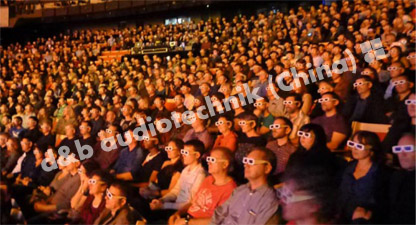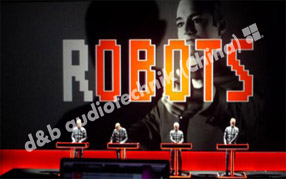Kraftwerk Get Vivid in 3D
2013-09-13
As if the prospect of Kraftwerk at the Sydney Opera House wasn’t exciting enough, the recent Vivid LIVE festival implemented 3D sound as well
Sydney into a ‘spectacular canvas of light, music and ideas’, the unique event that is Vivid Sydney returned to the city for the fifth time at the beginning of June. It brought with it a remarkable series of events including immersive light installations and more, but arguably the hottest ticket of the event belonged to Vivid LIVE, the live music portion of the festival which this year saw German electronic music pioneers Kraftwerk perform eight concerts over four nights at the Sydney Opera House.
In itself, that’s a tantalising proposition for any fan of live music, but the Vivid LIVE concerts also added the incentive of a union of three-dimensional visuals and 3D sound reinforcement courtesy of d&b audiotechnik. The result took place in the Opera House’s Joan Sutherland Theatre (JST) – the same venue that previously hosted a celebrated 3D sound production of Die Tote Stadt in 2012, again using d&b.
‘What Kraftwerk presented combined the profound elements of three dimensional sound and vision with the ground breaking musical invention of their first eight studio albums,’ explains Jeremy Christian, acting technical manager for the Opera House. ‘In that sense they fulfilled every obligation of the Vivid remit. While the 3D visual element was a relatively straight forward matter of positioning the necessary projectors and issuing the audience with 3D glasses, distilling the essence of their dynamic three dimensional sound panoramas into our opera hall was an altogether more contentious proposition.’
Head of sound Steve McMillan picks up the story: ‘The great thing was the amount of preproduction devoted to achieving as potent a rendition of the desired 3D environment as possible,’ he says. ‘We had people in the roof for several weeks laying cable in preparation. Although it only took two days to bump in all the loudspeakers it was six weeks in preproduction.’
 The system deployed to meet the challenge was surprisingly similar to that Kraftwerk had used before. ‘At the stage we positioned a left-right system of d&b V-Series: three V12 and five V8 per-side with four arrays of six T10 above the proscenium,’ explains systems supervisor Richard Fenton. ‘We worked out our solution from the first set of ArrayCalc files Ralf Zuleeg sent from d&b Applications Support in Germany; this defined the number of loudspeakers and the desired positions. Fortunately for us, Ralf has almost become part of the furniture at the JST; it was Ralf who helped us implement the 3D sound environment that made our presentation of Die Tote Stadt such a success last year; but while Tote was concerned with evoking the sound image of an orchestra not physically present in the concert hall, Kraftwerk exploited the concept of 3D sound in a more playful fashion.’
The system deployed to meet the challenge was surprisingly similar to that Kraftwerk had used before. ‘At the stage we positioned a left-right system of d&b V-Series: three V12 and five V8 per-side with four arrays of six T10 above the proscenium,’ explains systems supervisor Richard Fenton. ‘We worked out our solution from the first set of ArrayCalc files Ralf Zuleeg sent from d&b Applications Support in Germany; this defined the number of loudspeakers and the desired positions. Fortunately for us, Ralf has almost become part of the furniture at the JST; it was Ralf who helped us implement the 3D sound environment that made our presentation of Die Tote Stadt such a success last year; but while Tote was concerned with evoking the sound image of an orchestra not physically present in the concert hall, Kraftwerk exploited the concept of 3D sound in a more playful fashion.’
‘For the auditorium we placed 24 T10 loudspeakers in point source mode in two rings, one below and one above the balcony,’ Mr Fenton continues. ‘The lower ring covering the stalls were relatively easy; we already have pole mounts that sling over the lip of the loges down each side of the room. They are normally used for lighting but we just added standard d&b pole clamps and it was job done, though cable routing required time and patience.
‘Upstairs was much harder – the physical design called for the T10 boxes to be equally spaced every 3m. We used the ceiling house lighting positions, removing the lamp assembly and lowering a pole through. That sounds easy and at least the light positions do fall every metre so we were able to get the desired 3m spacing, but the T10 had to be mounted to the pole then heaved up (11kgs plus the pole), and running the cables to the loudspeakers was another matter.’
Steve McMillan ran many of the cables, struggling with space constraints. ‘In some places there was barely crawl space between the inner wooden architecture of the room and the concrete shell above, he recalls.
The result, however, was worth it.‘Most people in the audience got the surround field, says Mr McMillan,‘Kraftwerk’s sound engineer, Serge Graefe, and his 3D software assistant, Felix Einseidel, achieved great things in terms of fidelity and spatial dynamics.The motion inherent in something like Trans Europe Express was unavoidable.’
‘The producers here also loved it,’ adds Mr Christian. ‘There are about 20 seats behind the mix position that we can’t sell because of public access rules and they were full each night with sound departments from other parts of the building. The Vivid festival organiser Ferguson Lenehan had nothing but praise. He told me he knew he enjoyed it, but not being a sound geek he didn’t know quite why it was so enjoyable. That’s exactly the result we want – for the sound to be unexpected.’
*Source from Pro Audio Asia magazine Issue 2013 September -October